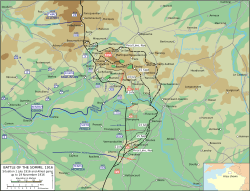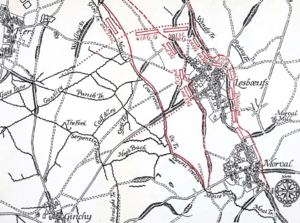Capture of Lesbœufs facts for kids
Quick facts for kids Capture of Lesbœufs |
|||||||
|---|---|---|---|---|---|---|---|
| Part of the Battle of the Somme, First World War | |||||||
 Battle of the Somme 1 July – 18 November 1916 |
|||||||
|
|||||||
| Belligerents | |||||||
| Commanders and leaders | |||||||
| Strength | |||||||
| 2 brigades | 1 regiment | ||||||
| Casualties and losses | |||||||
| c. 2,151 (incomplete) | (not known) 500 prisoners | ||||||
The Capture of Lesbœufs was an important event during the Battle of the Somme in the First World War. It happened on September 25, 1916. Lesbœufs is a small village in northern France, about 30 miles (48 km) north-east of Amiens.
In the early days of the war, German troops moved through Lesbœufs. The front line then settled west of the village. Later, during the Battle of Flers–Courcelette (September 15–22), British forces pushed closer to Lesbœufs. However, they were too tired to capture the village right away.
The British Fourth Army and the French Sixth Army planned a joint attack. Bad weather delayed their plans several times. Finally, the Battle of Morval began on September 25. British soldiers from the 6th Division and the Guards Division attacked Lesbœufs. They quickly took over the German defenses and the village. The Germans had no troops ready to counter-attack. The British then made the village secure. The next day, nearby Gueudecourt was also captured, linking the new front lines.
A few days later, Lesbœufs was given to the French Sixth Army. This allowed the French to attack another village, Sailly-Saillisel, from the west. British attacks continued in the area during the Battle of Le Transloy in October. The fighting slowed down during the winter of 1916–1917. The area became quiet after the Germans moved back to the Hindenburg Line in March 1917. Lesbœufs was briefly captured by the Germans again in March 1918 during Operation Michael. However, British troops took it back for good on August 29, 1918.
Background to the Battle
Early Fighting (1914)
In September 1914, during the "Race to the Sea," French forces attacked German troops north of the Somme River. This forced the Germans to retreat quickly. As more German units arrived, they pushed forward through villages like Bouchavesnes and Hardecourt. They aimed to reach the sea by advancing down the Somme valley. French armies stopped their advance east of Albert.
The Somme Campaign (1916)
During the Battle of Albert (July 1–13, 1916), German soldiers suffered many losses. By July 14, some German units were very small. On August 27, the British captured Delville Wood. The Germans planned a counter-attack for August 31. German infantry marched through Le Transloy, Lesbœufs, and Flers towards the front line.
On September 14, British artillery heavily bombed German defenses near Lesbœufs. On September 15, the British used tanks for the first time in the Battle of Flers–Courcelette. German artillery hit one tank, and its crew was shot as they came out. German infantry were seen retreating towards Lesbœufs, leaving the road open. British troops reached Flers and tried to advance towards Lesbœufs. However, German artillery prevented them from taking the main German trenches.
Small groups of British Guards Division soldiers reached Lesbœufs. They took cover in a trench for hours before retreating during a German counter-attack. For a while, the village was empty. But the British had suffered too many casualties earlier that day to send in more troops. The Guards Division eventually dug in just west of the main German trenches in front of Lesbœufs.
Preparing for the Attack
British Preparations
The British 6th Division rested from September 16–20. They returned to the front line on September 21 and began digging new trenches for the attack. Their most advanced position was a captured trench, which the Germans still held on both sides.
The Guards Division also rested after the Battle of Flers–Courcelette. They had suffered almost 5,000 casualties from September 10–17. Luckily, they had many trained reserve soldiers to replace their losses. On September 19, their commander, Major-General Feilding, emphasized the importance of staying on course during the attack. He also told his brigades to plan carefully for attacking Germans hiding in cellars and dugouts in Lesbœufs. New starting trenches were dug in safe areas. Reserve battalions were kept ready to help if the attacking troops were pushed back.
British Attack Plan
The British planned to advance about 1,200 to 1,500 yards (1,100 to 1,400 m). This would help them reach the final goals set for the earlier Battle of Flers–Courcelette. The attack would happen in three stages.
The first stage began at 12:35 p.m. The goal was to reach the main German trenches (called Gird Trenches) south of Gueudecourt. The second stage started at 1:35 p.m. The troops would advance along a sunken road west of Morval and Lesbœufs, and through the center of Gueudecourt. The final stage began at 2:35 p.m., aiming to reach the eastern side of Morval, Lesbœufs, and Gueudecourt by 3:00 p.m.
Tanks were kept in reserve because it was hard to hide them during a daytime attack. They were ready to help attack the villages at the final stage. Cavalry units were also ready to move forward if Lesbœufs and Gueudecourt were captured quickly.
The 6th Division was to attack the area from Morval to the middle of Lesbœufs. Instead of artillery, they would use a lot of machine-gun and mortar fire at the start of the attack. The Guards Division attacked with two brigades. Their goals were set in stages, marked by "green," "brown," and "blue" lines on maps. Their artillery would bomb German positions for hours before the attack. During the attack, half the guns would fire a constant barrage, and the other half would fire a "creeping barrage" that moved forward with the infantry.
German Defenses
After General Erich von Falkenhayn was replaced on August 29, the new German leaders, General Paul von Hindenburg and General Erich Ludendorff, ordered an end to attacks at Verdun. They focused on strengthening the Somme front. They also changed their defense tactics to be more flexible.
After the Battle of Flers–Courcelette, new German divisions took over the defenses around Lesbœufs. The main German trenches, Gird Trench and Gird Support Trench, were about 500 yards (460 m) apart. They were dug to defend against an attack from the southwest. Other strong points like Seven Dials and Factory Corner protected the village from the west. A farm called Luisenhof Farm was also fortified to the northwest.
The Battle for Lesbœufs
September 25, 1916
The weather was good, and the ground was much drier than during earlier battles. The British 6th Division attacked at 12:35 p.m. They moved from the left side of the 5th Division, north of Morval, towards the road through Lesbœufs. They quickly captured their first objective. Then, other battalions pushed through to take the final objective east of the Morval–Lesbœufs road. They cleared the southern part of Lesbœufs, where they met the Guards Division.
Two German battalions were completely overwhelmed. The British took about 500 prisoners. The 6th Division then made their new positions secure on hills east and northeast of Morval. At 6:00 p.m., the brigades advanced another 200 yards (180 m) east of Morval. They also set up posts from Morval Mill north to Lesbœufs.
The Guards Division attacked with two brigades. The 1st Guards Brigade advanced in waves, 75 yards (69 m) apart. As soon as they started, a German artillery barrage hit the British front line, causing many casualties to the support battalions. However, the first waves moved fast enough to avoid the shelling. They were close to the German front line when the British barrage lifted.
Uncut barbed wire and machine-gun fire from dugouts along a sunken road slowed down the right-hand battalion. Officers had to cut the wire, and many were shot by German defenders. The soldiers provided covering fire and then rushed the first objective around 12:40 p.m. Both battalions captured the "green line" (first objective) by 1:20 p.m.
The advance to the next objective at 1:35 p.m. took only ten minutes. There was "slight" resistance. The Guards Division connected with the 6th Division on their right and the 3rd Guards Brigade on their left. At 2:35 p.m., the final advance began with little resistance. Many Germans surrendered. The 1st Guards Brigade battalions started digging in on the east side of Lesbœufs by 3:30 p.m.
The 3rd Guards Brigade also advanced on time. Their right-hand battalion reached the "green line" easily. On the left, they found an undamaged German trench full of soldiers who fought hard, causing many casualties. About 150 Germans were killed there. The battalion reorganized and reached the first objective at 1:35 p.m. They found their left side was open because another British division had been delayed by uncut wire. They formed a defensive line, and the remaining troops advanced to the second objective. More troops were sent to reinforce the open flank. The "brown line" (third objective) was reached by 3:30 p.m. They connected with the 6th Division north of Lesbœufs. A further advance that evening was postponed because their northern flank was still vulnerable.
Aftermath
Casualties
The 6th Division captured 500 German prisoners, six machine-guns, and four large trench mortars. The division lost about 5,000 soldiers from September 14–30. The Guards Division had 2,340 casualties from September 18–30, with about 90 percent of those losses happening on September 25.
Later Operations
After the Battle of Morval, the British Fourth Army continued to attack German defenses. However, they only managed to advance a few hundred yards. The Germans successfully defended their fourth main defensive line during the Battle of Le Transloy in October. By attacking in the area from Lesbœufs to Le Sars, the British moved into lower, swampy ground that the Germans on Transloy Ridge could easily see.
By November 2, German leaders noted that the British were digging in for winter. This suggested that only small operations would continue. Infantry attacks decreased, but British artillery fire was constant. German counter-attacks were canceled due to a shortage of troops. During the quiet winter of 1916–1917, there were still snipers, trench raids, and artillery exchanges. This continued until the German retreat to the Hindenburg Line in March 1917.
1918
Lesbœufs was lost again on March 24, 1918, during Operation Michael, the German spring offensive. British machine-gunners tried to defend the village. The village was recaptured for the last time on August 29, 1918, by the 38th (Welsh) Division during the Second Battle of Bapaume.


